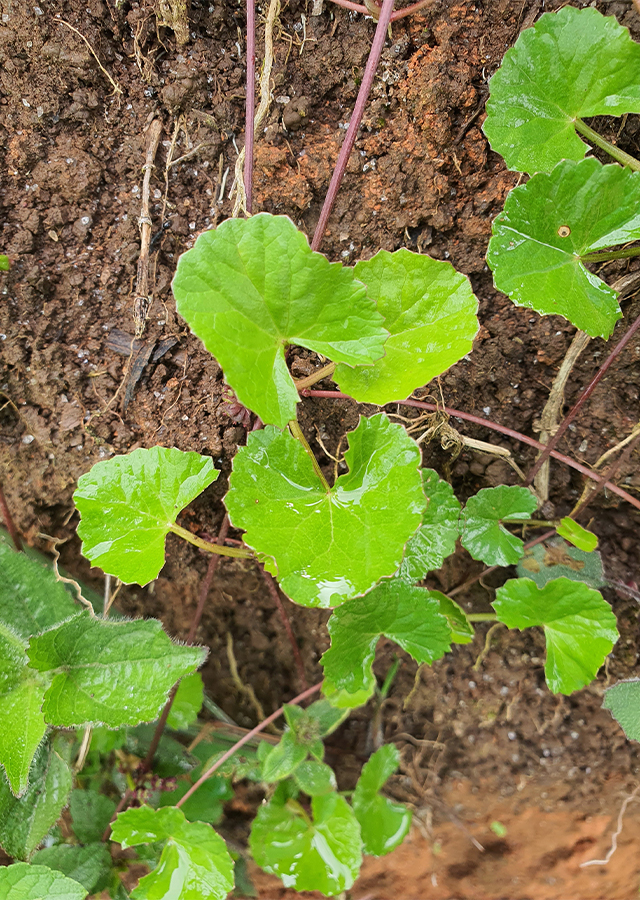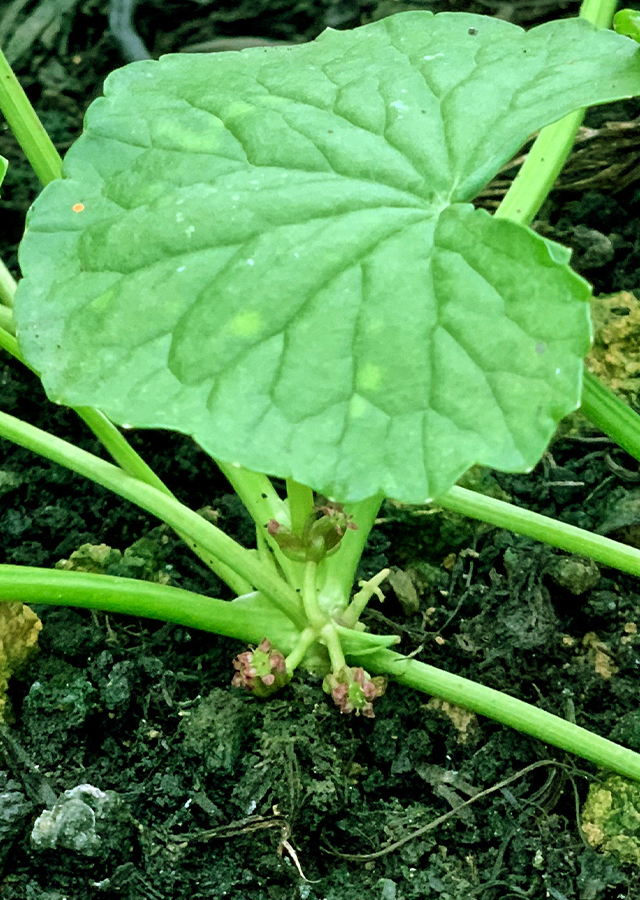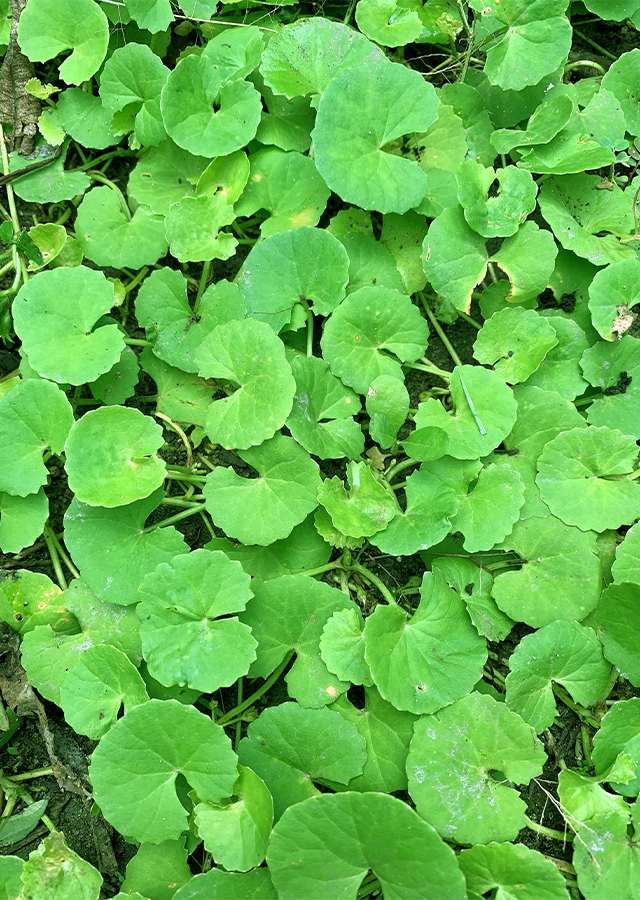Indian Pennywort
Centella asiatica (L.) Urb.
Apiaceae
Location in our garden
Principal



Synonym
Centella boninensis Nakai ex Tuyama
Centella coriacea Nannf.
Centella glochidiata (Benth.) Drude
Habitus
Herbaceous. An evergreen perennial, creeping ground cover plant, pseudo-stems, about 20 cm tall.
Part Used
The Whole Plant
Growing Requirements
Full Sunshine
Habitat
Wetland
Riverbanks
Forest
Roadside
Grassland
Overview
The Indian pennywort grows natively in tropical America, Africa, China, Japan, West Pakistan, and the Pacific. it is native to southern U.S and India. It is regarded as an ancient Ayurvedic cure that is now commonly used in the West. The crop grows and flowers throughout the year. In India and Indonesia, it is used as salads. One of the major pollen sources for honeybees is recorded to be in the Philippines.
Vernacular Names
Centelle asiatique (French), Gotu kola (Hindi-India), Tsubo kusa (Japanese), Pegaga (Brunei, Singapore, Malaysia), Phak nok (Laos), Takip-kohol (Philippines), Bua bok (Thai).
Agroecology
This plant is growing well in subtropical and tropical lowland areas. It occurs in slightly shaded or sunny, humid areas, prefers damp habitats (preferably sandy loams with a lot of organic matter), e.g., along stream banks, along walls, on or near roads, open grasslands, from sea level up to an altitude of 2,500 m. This plant will grow on a wide range of soil types, including clay, but favours lighter soils with clay content.
Morphology
- Roots - rooting at the nodes with long stolons, but sometimes forming a large taproot, minutely pubescent at the young stage.
- Stem - terete, creeping with long stolons (up to 2.5 m long), striated, glabrous, with shallow grooves, sometimes purplish.
- Leaves - green, simple, in cluster of 1-4, orbicular-renniform or fan shape, 1-4 cm by 1-7 cm with a crenate or dentate margin, glabrous on both sides.
- Flowers - umbels with white or light purple to-pink petals, ovate to orbicular, inconspicuous, hermaphrodite, peduncles 1-4 cm long, scizocarp sub-cylindric.
- Fruits - 3.5 x 3 mm, orbicular to ellipsoid, consisting of 2 one-seeded mericarps, brown at maturity, pubescent when young but often glabrescent and flattened laterally.
Cultivation
- Propagation is done generatively by seeds, sometimes vegetatively by runners which root on the nodesl. Stems buried in the soil will regenerate into new individuals
- Plant the seeds in a bottom container with a drainage hole, give water as required to keep the soil uniformly and reliably moist. Then transplant the small plant into individual containers when they have at least one set of real leaves, then plant them on the permanent ground as mature plants (several months of age).
Chemical Constituents
- Centellin, asiaticin, and centellicin, alkaloid, triterpenic acid (asiatic acid madecassic acid), triterpenic saponin (madecassoside and asiaticoside), glycosides, triterpene glycosides, anthraquinone glycosides, sterols, sitosterol, tannins, sugars, resin, saponin, asiatic acid, asiaticoside, thankuniside, isothankuniside, ascorbic , pectic, brahmic, isobrahmic acid, essential oil, vellarine, bitter principle, hydrocotyline, pollyacetylenes (I, II, III, IV), and acetylenes.
Traditional Medicinal Uses
- The most important use of the whole plant is in skin-related diseases. It is also hypotensive, alterative, cardio-depressive, weakly sedative and tonic.
- Orally, the extract is recommended for the treatment of atonic wounds and hypertropic healing to alleviate the symptoms of venous and lymphatic vessel insufficiency.
- Activity against the herpes simplex II virus was demonstrated in an aqueous extract of the plant.
- The plant is used for diarrhea, diuretics, gravel, leprosy cure, stones, wound healing and as a tonic in cooling drinks when boiled. It is a rejuvenating herb that destroys toxins, decreases inflammation and fever, improves healing and immunity, improves memory, and has a balancing effect on the nervous system.
- It is used by the Chinese to stimulate appetite, help digestion, treat sores and ulcers.
- It is used in India for the treatment of skin, nervous system, and blood disorders. It is part of a colic drug mixture in Indonesia.
- Fresh leaves, fresh juice, a decoction or an extract are added, depending on the complaints.
Part Used
Reference Sources
- Seevaratnam, V., Banumathi, P., Premalatha, M. R., Sundaram, S. P., & Arumugam, T. (2012). Functional properties of Centella asiatica (L.): a review. Int J Pharm Pharm Sci, 4(5), 8-14.
- Siddiqui, B. S., Aslam, H., Ali, S. T., Khan, S., & Begum, S. (2007). Chemical constituents of Centella asiatica. Journal of Asian natural products research, 9(4), 407-414.
- https://www.natureinfo.com.bd/centella-asiatica/
- https://uses.plantnet-project.org/en/Centella_asiatica_(PROSEA)
- https://www.cabi.org/isc/datasheet/12048

